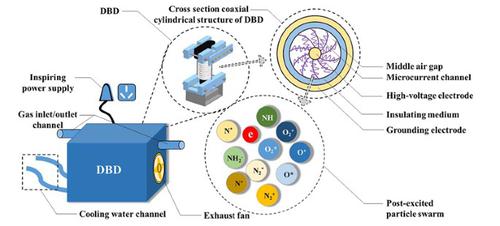Frontiers of Chemical Science and Engineering ( IF 4.3 ) Pub Date : 2022-06-27 , DOI: 10.1007/s11705-022-2165-z Yue Liu , Ji-Wei Wang , Jian Zhang , Ting-Ting Qi , Guang-Wen Chu , Hai-Kui Zou , Bao-Chang Sun

|
Green and efficient NOx removal at low temperature is still desired. NOx removal via non-thermal plasma (NTP) reduction is one of such technique. This work presents the experimental and theoretical study on the NOx removal via NTP reduction (NTPRD) in dielectric barrier discharge reactor (DBD). The effect of O2 molar fraction on NOx species in the outlet of DBD, and effects of NH3/NO molar ratio and discharge power of DBD on NOx removal efficiency are investigated. Results indicate that anaerobic condition and higher discharge power is beneficial to direct removal of NOx, and the NOx removal efficiency can be up to 98.5% under the optimal operating conditions. It is also found that adding NH3 is favorable for the reduction of NOx to N2 at lower discharge power. In addition, the NOx removal mechanism and energy consumption analysis for the NTPRD process are also studied. It is found that the reduced active species (N*, N−, N+, N2*, NH2+, etc.) generated in the NTPRD process play important roles for the reduction of NOx to N2. Our work paves a novel pathway for NOx removal from anaerobic gas in industrial application.
中文翻译:

通过非热等离子体还原去除 NOx:实验和理论研究
仍然需要在低温下绿色和高效的 NO x去除。通过非热等离子体 (NTP) 还原去除NO x是此类技术之一。本工作介绍了在介质阻挡放电反应器 (DBD) 中通过 NTP 还原 (NTPRD) 去除NO x的实验和理论研究。研究了O 2摩尔分数对DBD出口NO x形态的影响,以及NH 3 /NO摩尔比和DBD放电功率对NO x去除效率的影响。结果表明,厌氧条件和较高的放电功率有利于直接去除NO x,而NO x在最佳操作条件下去除效率可达98.5%。还发现添加NH 3有利于在较低的放电功率下将NO x还原为N 2 。此外,还研究了NTPRD工艺的NO x去除机理和能耗分析。发现在NTPRD过程中产生的还原活性物质(N*、N -、N +、N 2 *、NH 2 +等)对NO x还原为N 2起重要作用。我们的工作为工业应用中从厌氧气体中去除NO x开辟了一条新途径。











































 京公网安备 11010802027423号
京公网安备 11010802027423号